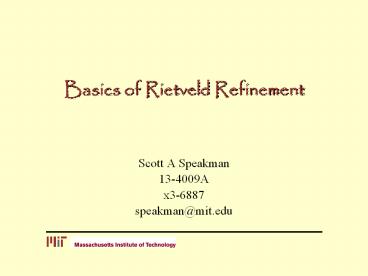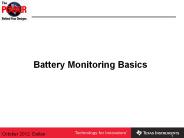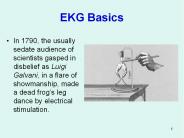Basics%20of%20Rietveld%20Refinement - PowerPoint PPT Presentation
Title:
Basics%20of%20Rietveld%20Refinement
Description:
... statistics appropriate step size sample transparency surface roughness preferred orientation particle size go to XRD Basics pg 102 Describing the Crystal ... – PowerPoint PPT presentation
Number of Views:437
Avg rating:3.0/5.0
Title: Basics%20of%20Rietveld%20Refinement
1
Basics of Rietveld Refinement
- Scott A Speakman
- 13-4009A
- x3-6887
- speakman_at_mit.edu
2
Uses of the Rietveld Method
- The Rietveld method refines user-selected
parameters to minimize the difference between an
experimental pattern (observed data) and a model
based on the hypothesized crystal structure and
instrumental parameters (calculated pattern) - can refine information about a single crystal
structure - confirm/disprove a hypothetical crystal structure
- refine lattice parameters
- refine atomic positions, fractional occupancy,
and thermal parameter - refine information about a single sample
- preferred orientation
- refine information about a multiphase sample
- determine the relative amounts of each phase
3
Requirements of Rietveld Method
- High quality experimental diffraction pattern
- a structure model that makes physical and
chemical sense - suitable peak and background functions
4
Obtaining High Quality Data
- issues to consider
- aligned and calibrated instrument
- beam overflow problems
- thin specimen error
- good counting statistics
- appropriate step size
- sample transparency
- surface roughness
- preferred orientation
- particle size
- go to XRD Basics pg 102
5
Describing the Crystal Structure
- space group
- lattice parameters
- atomic positions
- atomic site occupancies
- atomic thermal parameters
- isotropic or anisotropic
6
The Crystal Structure of LaB6
- LaB6
- Space Group Pm-3m (221)
- Lattice Parameter a4.1527 A
Atom Wyckoff Site x y z B occ.
La 1a 0 0 0 0.00157 1
B 6f 0.1993 0.5 0.5 0.0027 1
7
Where to get crystal structure information
- check if the structure is already solved
- websites
- Inorganic Crystal Structure Database (ICSD)
http//icsd.ill.fr/icsd/index.html - 4 is available for free online as a demo
- Crystallography Open Database http//www.crystallo
graphy.net/ - Mincryst http//database.iem.ac.ru/mincryst/index.
php - American Mineralogist http//www.minsocam.org/MSA/
Crystal_Database.html - WebMineral http//www.webmineral.com/
- databases
- PDF4 from the ICDD
- Linus Pauling File from ASM International
- Cambridge Structure Database
- literature
- use the PDF to search ICSD listings and follow
the references - look for similar, hopefully isostructural,
materials - index the cell, and then try direct methods or
ab-initio solutions - beyond the scope of todays class
8
Instrumental Parameters
- background
- peak profile parameters
- cagliotti parameters u, v, w
- pseudo-voigt or other profile parameters
- asymmetry correction
- anisotropic broadening
- error correcting parameters
- zero shift
- specimen displacement
- absorption
- extinction
- roughness
- porosity
9
How many parameters can we refine?
- Each diffraction peak acts as an observation
- theoretically, refine n-1 parameters
- refining a tetragonal LaNi4.85Sn0.15 crystal
structure, there might be - scale factor
- 2nd order polynomial background 3 parameters
- 2 lattice parameters
- no atomic positions (all atoms are fixed)
- 3 or 5 thermal parameters
- 2 or 4 occupancy factors
- zero shift and specimen displacement
- 5 profile shape parameters
- 22 parameters maximum with 43 peaks (20 to 120
deg 2theta) - does this mean we can refine all parameters?
10
background functions
- manually fit background
- polynomial
- chebyshev
- shifte chebyshev
- amorphous sinc function
- many others for different programs
11
profile functions
- vary significantly with programs
- almost all programs use Cagglioti U, V, and W
- HSP uses pseudo-voigt, Pearson VII, Voigt, or
pseudo-voigt 3 (FJC asymmetry) - GSAS uses functions derived more from neutron and
synchrotron beamlines
12
- go to parameters_calc_pattern.pdf
13
How do you know if a fit is good?
- difference pattern
- Residuals R
- R is the quantity that is minimized during
least-squares or other fitting procedures - Rwp is weighted to emphasize intense peaks over
background - Rexp estimates the best value R for a data set
- an evaluation of how good the data are
- RBragg tries to modify the R for a specific phase
- GOF (aka X2)
14
Refinement Strategy
- Rietveld methods fit a multivarialbe
structure-background-profile model to
experimental data - lots of potential for false minima, diverging
solutions, etc - need to refine the most important variables
first, then add more until an adequate solution
is realized - a correct solution may not result
15
Ray Youngs Refinement Strategy
- scale factor
- zero shift or specimen displacement (not both)
- linear background
- lattice parameters
- more background
- peak width, w
- atom positions
- preferred orientation
- isotropic temperature factor B
- u, v, and other profile parameters
- anisotropic temperature factors
16
HSP Automatic Refinement Strategy
- Very similar to Prof Youngs recommendations
- a good choice for beginners
- you can set limits on any of these parameters
17
Additional Files
- XRD_Basics_HSP_2006.pdf
- large collection of information about X-ray
diffraction, instrumentation, and different
techniques - XPert HighScore Plus Tutorial.pdf
- overview of the different functionality available
in HighScore Plus - Introduction.pdf
- overview of Rietveld
- parameters_calc_patterns.pdf
- overview of parameters involved in calculating a
diffraction pattern
18
further reading
- Rietveld refinement guidelines, J. Appl.Cryst.
32 (1999) 36-50 - R.A. Young (ed), The Rietveld Method, IUCr 1993
- V.K. Pecharsky and P.Y. Zavalij, Fundamentals of
Powder Diffraction and Structural
Characterization of Materials, Kluwer Academic
2003. - DL Bish and JE Post (eds), Modern Powder
Diffraction, Reviews in Mineralogy vol 20, Min.
Soc. Amer. 1989. - CCP14 website http//www.ccp14.ac.uk/tutorial/tuto
rial.htm - prism.mit.edu/xray/resources.htm
19
Rietveld Programs
- Free
- GSAS ExpGUI
- Fullprof
- Rietica
- PSSP (polymers)
- Maud (not very good)
- PowderCell (mostly for calculating patterns and
transforming crystal structures, limited
refinement) - Commercial
- PANalytical HighScore Plus
- Bruker TOPAS (also an academic)
- MDI Jade or Ruby
20
Examples
- Silicon
- LaB6
- intermetallic LaNi4.85Sn0.15
21
Silicon
- Open the datafile in HSP
- Add the structure model
- insert the structure manually
- import (insert) a struture file
- usually use the CIF format the ubiquitous
standard for crystal structures - HSP can also import ICSD .cry files and
structures from other refinement programs - GSAS can import CIF or PowderCell files
- try the automatic refinement
- manually improve the fit
22
Silicon Crystal Structure
- Fd3m
- which setting? (2)
- a5.43 A
- Si at 0.125, 0.125, 0.125
23
Lanthanum hexaboride LaB6
- Open the datafile
- insert the crystal structure CIF file
- Note that boron (z5) makes little difference in
the XRD pattern compared to the lanthanum (z57) - what can we do to improve the fit
24
LaNi4.85Sn0.15
- The data was taken from Chapter 6 of Fundamentals
of Powder Diffraction and Structural
Characterization of Materials, by Pecharsky and
Zavalij - The structure is a bit more complex that our
earlier example, which allows us to explore more
features of HighScore Plus - The data (Ch6_1.raw) is in GSAS format, which can
be read into HighScore Plus - I have also included a CIF file from the ICSD
(104685) with all the main features of the
structure described
25
Issue to Consider
- How can I work without knowledge of the
structure? - Use LeBail or Pawley method to determine lattice
parameters - Try indexing and solving the structure using the
HighScore Plus tools - You will find that there are 16 possible space
groups for this material, but picking the most
common (and simplest) choice, P6/mmm, is the
right way to go - Where do I put the atoms?
- You can use a Fourier map to find out wherein the
structure the electron densities are greatest.
Put the heaviest atoms (La) at these sites, then
work your way through the chemistry - What variables do I refine and in what sequence?
- Take a look at the automatic option in HSP -
this is not a bad strategy to use. We will go
through these in detail































